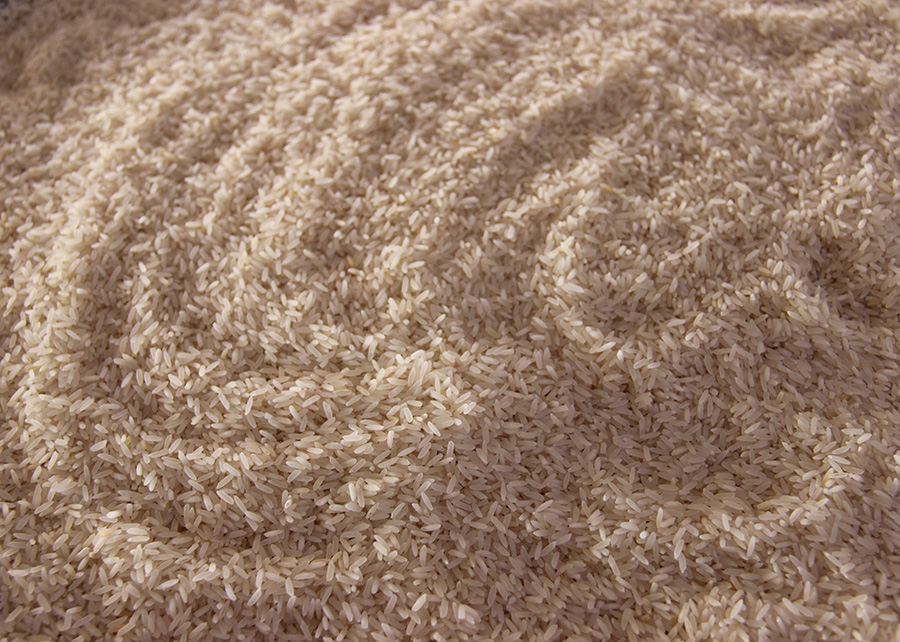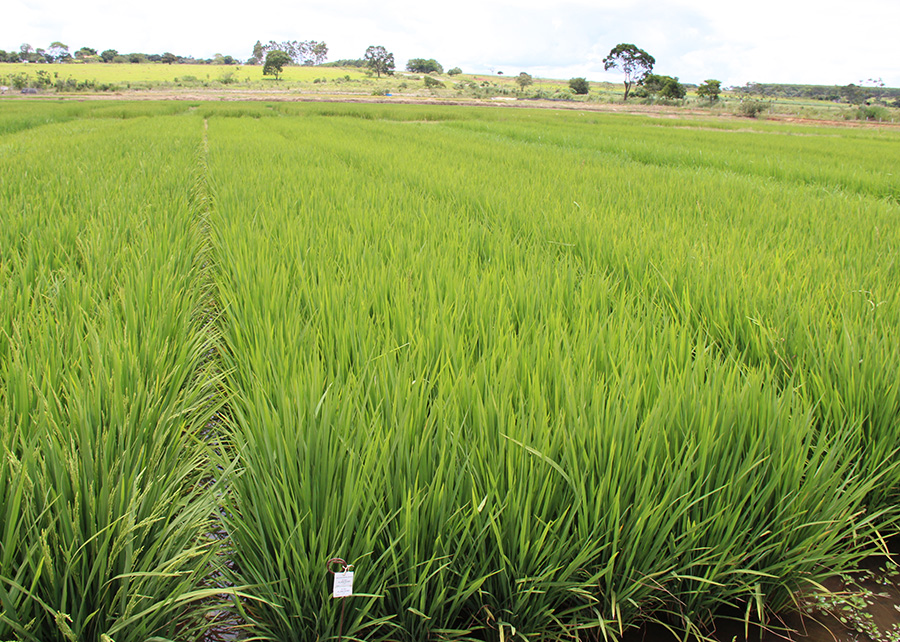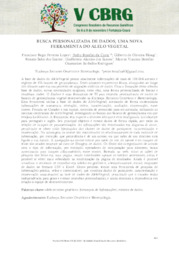Brazil started to integrate the Global Information System (Glis) maintained by FAO. This was kickstarted with the inclusion of 20,000 samples from the Rice Gene Bank (BAG Arroz, from the acronym in Portuguese, or Rice GB). The initiative opens doors for exchange with research institutions and for the use of national varieties in world breeding programs. The security of these operations is ensured by the digital object identifier (DOI), a tool that has been used for years to label documents on the Internet and that has recently been adapted for genetic resources. The DOI code was created based on The International Treaty on Plant Genetic Resources for Food and Agriculture (ITPGRFA) and allows tracing each sample through a single code, which works like a digital identity. The accessions in the Rice GB were the first ones recorded by Brazil, but the idea is to extend the initiative to all plant gene banks maintained by Embrapa. Brazil is the newest member of the Global Information System (Glis) maintained by the Food and Agriculture Organization of the United Nations (FAO) through the International Treaty on Plant Genetic Resources for Food and Agriculture (ITPGRFA). The inclusion of 20,000 samples from the Rice Active Germplasm Bank (BAG Arroz, from the acronym in Portuguese, or Rice GB) has kickstarted the membership and expanded the possibilities of consultation, exchange, and breeding and genetic improvement with international research institutions. And that includes a very important thing: the traceability of the samples from the Rice GB is safeguarded by the use of DOI (sigla em inglês para Digital Object Identifier), a code based on the ITPGRFA (learn more in the box below) to track plant genetic resources. The Rice GB's accessions were the first ones Brazil enlisted in the system, but the idea is to extend the initiative to all plant gene banks maintained by Embrapa, the researcher Rosa Lia Barbieri explains. It is an identification standard that has existed for some time to brand documents on the Internet, but the use on genetic resources is recent. “It is one of the most current and modern trends in research in the area and it represents a landmark for Brazilian agricultural research, since it grants a permanent unique identity that allows the samples to be tracked”, states the researcher. According to her, who headed the Supervision of the Plant Germplasm Curation System until late December 2020, the DOI is like a digital identity for the samples and makes it possible to identify when they are exchanged with other institutions and used in breeding programs. Information about the Rice GB had already been available for scientists in Brazil and from institutions that partnered with Embrapa through the Alelo System (see box), which gathers a total of 164 plant genebanks. Such data range from the origin of the variety to details like how often it was used and by which scientific organizations, all of which is well documented and searchable through a bar code. "The DOI submission represents another advance in the tool, since it is a permanent single code that allows us to trace all the information concerning the samples, and involves the more than 60 countries that undersign the ITPGRFA," observes Barbieri, who is also the representative of the Americas in the Svalbard Global Seed Vault. What is ITPGRFA? A treaty signed by countries that are members of theFood and Agriculture Organization of the United Nations (FAO), which aims at the conservation and the sustainable use of all plant genetic resources for food and agriculture and the fair and equitable sharing of the benefits resulting from their use, in line with the Convention on Biological Diversity, for sustainable agriculture and food security. To more have detailed information about ITPGRFA, click here. Treaty strengthens conservation, use and benefit-sharing The head of Embrapa Embrapa Rice and Beans, Elcio Guimarães, celebrates the partnership between the research and IT teams at his research center with Embrapa Genetic Resources and Biotechnology for the world visibility that the company has reached with one of the most important crops in human diets being included in Glis. "The ITPGRFA, based on the tripod conservation, use and benefit-sharing, is an important instrument signed by several countries, which recognizes the contribution of farmers to the crop diversity that supports feeding the world population”, Guimarães states. “Moreover, the treaty establishes a global system to provide farmers, plant breeders and scientists with access to plant genetic materials. Hence the ITPGRFA makes sure that end countries share the benefits resulting from the use of genetic materials with the countries from where such materials originate," observes the head of Embrapa Genetic Resources and Biotechnology, Cléria Inglis.he explains that the whole process of receiving and submitting germplasm is is organized by the technical coordinators of the Germplasm Curation System and 100% of the information on the accessions of plant genetic resources are organized in the Alelo System, which is also coordinated by the same Embrapa Unit. “The traceability of plant genetic resources kept in ex situ conditions is fundamental to meet the treaty's requirements, which is only possible due to Embrapa's organization and Curation System”, the researcher asserts. Alelo Plants is link with international systems A link between the Embrapa and the information systems of gene banks in international institutions, Alelo Plants, which is already part of Genesys a system containing information on Plant Genetic Resources for Food and Agriculture/PGRFA conserved in gene banks around the globe), now connects the Rice GB to the GLIS. The IT analyst from Embrapa Genetic Resources and Biotechnology Renato Sales worked with the IT and research teams of Embrapa Rice and Beans not only for the necessary adjustments to feed Alelo's plant component, but also on the platform that places the Brazilian corporation on the international stage. Sales reports that in order to have all the data from the Rice GB be recorded and made available to the world's scientific community through GLIS, it was necessary to consolidate a database with IT resources that not only made the consultations possible, but also “talked” with the international platforms that had been instituted for the same purpose. Hence the importance of the single code obtained by Embrapa for the Rice GB. For that purpose, Embrapa Genetic Resources and Biotechnology has not only created but also updated (jointly with other Embrapa Units) the Alelo Plants web portal, where one can find all the data from Embrapa's base collection (Colbase). This repository is the largest plant gene bank of Latin America, with 127,783 samples of seeds from 1,019 plant species, conserved in a temperature of -18ºC. Alelo Portal It is an information website that hosts systems resources and tools to support the management of research and development data on Embrapa's genetic resources. Alelo is composed by a set of systems conceived and implemented according to their research source (animals, microorganisms or plants), with the aim to provide passport, characterization and assessment data of the research and development collections: 1. AleloAnimal System - management of data from animal genetic resources; 2. AleloMicro System - management of data from microorganism collections, including from the Center of Biological Resources (CRB); and 3. AleloVegetal System - management of data and information on Research and Development with Plant Genetic Resources, especially dedicated to the gene banks or Active Germplasm Banks (AGBs) at Embrapa and partner institutions. Photo: Cláudio Bezerra
Photo: Cláudio Bezerra

The inclusion of samples from the Rice Gene Bank expands consultation, exchange, and breeding and genetic improvement opportunities with international research institutions
-
Brazil started to integrate the Global Information System (Glis) maintained by FAO. -
This was kickstarted with the inclusion of 20,000 samples from the Rice Gene Bank (BAG Arroz, from the acronym in Portuguese, or Rice GB). -
The initiative opens doors for exchange with research institutions and for the use of national varieties in world breeding programs. -
The security of these operations is ensured by the digital object identifier (DOI), a tool that has been used for years to label documents on the Internet and that has recently been adapted for genetic resources. -
The DOI code was created based on The International Treaty on Plant Genetic Resources for Food and Agriculture (ITPGRFA) and allows tracing each sample through a single code, which works like a digital identity. -
The accessions in the Rice GB were the first ones recorded by Brazil, but the idea is to extend the initiative to all plant gene banks maintained by Embrapa. |
Brazil is the newest member of the Global Information System (Glis) maintained by the Food and Agriculture Organization of the United Nations (FAO) through the International Treaty on Plant Genetic Resources for Food and Agriculture (ITPGRFA). The inclusion of 20,000 samples from the Rice Active Germplasm Bank (BAG Arroz, from the acronym in Portuguese, or Rice GB) has kickstarted the membership and expanded the possibilities of consultation, exchange, and breeding and genetic improvement with international research institutions.
And that includes a very important thing: the traceability of the samples from the Rice GB is safeguarded by the use of DOI (sigla em inglês para Digital Object Identifier), a code based on the ITPGRFA (learn more in the box below) to track plant genetic resources. The Rice GB's accessions were the first ones Brazil enlisted in the system, but the idea is to extend the initiative to all plant gene banks maintained by Embrapa, the researcher Rosa Lia Barbieri explains.
It is an identification standard that has existed for some time to brand documents on the Internet, but the use on genetic resources is recent. “It is one of the most current and modern trends in research in the area and it represents a landmark for Brazilian agricultural research, since it grants a permanent unique identity that allows the samples to be tracked”, states the researcher.
According to her, who headed the Supervision of the Plant Germplasm Curation System until late December 2020, the DOI is like a digital identity for the samples and makes it possible to identify when they are exchanged with other institutions and used in breeding programs.
Information about the Rice GB had already been available for scientists in Brazil and from institutions that partnered with Embrapa through the Alelo System (see box), which gathers a total of 164 plant genebanks. Such data range from the origin of the variety to details like how often it was used and by which scientific organizations, all of which is well documented and searchable through a bar code. "The DOI submission represents another advance in the tool, since it is a permanent single code that allows us to trace all the information concerning the samples, and involves the more than 60 countries that undersign the ITPGRFA," observes Barbieri, who is also the representative of the Americas in the Svalbard Global Seed Vault.

| What is ITPGRFA? A treaty signed by countries that are members of theFood and Agriculture Organization of the United Nations (FAO), which aims at the conservation and the sustainable use of all plant genetic resources for food and agriculture and the fair and equitable sharing of the benefits resulting from their use, in line with the Convention on Biological Diversity, for sustainable agriculture and food security. To more have detailed information about ITPGRFA, click here. |
Treaty strengthens conservation, use and benefit-sharing
The head of Embrapa Embrapa Rice and Beans, Elcio Guimarães, celebrates the partnership between the research and IT teams at his research center with Embrapa Genetic Resources and Biotechnology for the world visibility that the company has reached with one of the most important crops in human diets being included in Glis. "The ITPGRFA, based on the tripod conservation, use and benefit-sharing, is an important instrument signed by several countries, which recognizes the contribution of farmers to the crop diversity that supports feeding the world population”, Guimarães states.
 “Moreover, the treaty establishes a global system to provide farmers, plant breeders and scientists with access to plant genetic materials. Hence the ITPGRFA makes sure that end countries share the benefits resulting from the use of genetic materials with the countries from where such materials originate," observes the head of Embrapa Genetic Resources and Biotechnology, Cléria Inglis.he explains that the whole process of receiving and submitting germplasm is is organized by the technical coordinators of the Germplasm Curation System and 100% of the information on the accessions of plant genetic resources are organized in the Alelo System, which is also coordinated by the same Embrapa Unit. “The traceability of plant genetic resources kept in ex situ conditions is fundamental to meet the treaty's requirements, which is only possible due to Embrapa's organization and Curation System”, the researcher asserts.
“Moreover, the treaty establishes a global system to provide farmers, plant breeders and scientists with access to plant genetic materials. Hence the ITPGRFA makes sure that end countries share the benefits resulting from the use of genetic materials with the countries from where such materials originate," observes the head of Embrapa Genetic Resources and Biotechnology, Cléria Inglis.he explains that the whole process of receiving and submitting germplasm is is organized by the technical coordinators of the Germplasm Curation System and 100% of the information on the accessions of plant genetic resources are organized in the Alelo System, which is also coordinated by the same Embrapa Unit. “The traceability of plant genetic resources kept in ex situ conditions is fundamental to meet the treaty's requirements, which is only possible due to Embrapa's organization and Curation System”, the researcher asserts.

 Alelo Plants is link with international systems
Alelo Plants is link with international systems
A link between the Embrapa and the information systems of gene banks in international institutions, Alelo Plants, which is already part of Genesys a system containing information on Plant Genetic Resources for Food and Agriculture/PGRFA conserved in gene banks around the globe), now connects the Rice GB to the GLIS. The IT analyst from Embrapa Genetic Resources and Biotechnology Renato Sales worked with the IT and research teams of Embrapa Rice and Beans not only for the necessary adjustments to feed Alelo's plant component, but also on the platform that places the Brazilian corporation on the international stage.
Sales reports that in order to have all the data from the Rice GB be recorded and made available to the world's scientific community through GLIS, it was necessary to consolidate a database with IT resources that not only made the consultations possible, but also “talked” with the international platforms that had been instituted for the same purpose. Hence the importance of the single code obtained by Embrapa for the Rice GB.
For that purpose, Embrapa Genetic Resources and Biotechnology has not only created but also updated (jointly with other Embrapa Units) the Alelo Plants web portal, where one can find all the data from Embrapa's base collection (Colbase). This repository is the largest plant gene bank of Latin America, with 127,783 samples of seeds from 1,019 plant species, conserved in a temperature of -18ºC.
 Alelo Portal Alelo Portal
It is an information website that hosts systems resources and tools to support the management of research and development data on Embrapa's genetic resources. Alelo is composed by a set of systems conceived and implemented according to their research source (animals, microorganisms or plants), with the aim to provide passport, characterization and assessment data of the research and development collections: 1. AleloAnimal System - management of data from animal genetic resources; 2. AleloMicro System - management of data from microorganism collections, including from the Center of Biological Resources (CRB); and 3. AleloVegetal System - management of data and information on Research and Development with Plant Genetic Resources, especially dedicated to the gene banks or Active Germplasm Banks (AGBs) at Embrapa and partner institutions. Photo: Cláudio Bezerra |
Deva Heberlê (MTb 5297/RS)
Embrapa Genetic Resources and Biotechnology
Press inquiries
recursos-geneticos-e-biotecnologia.imprensa@embrapa.br
Phone number: WhatsApp: +55 61 3208-4559
Mariana Medeiros (Translation - English)
General Secretariat
Further information on the topic
Citizen Attention Service (SAC)
www.embrapa.br/contact-us/sac/

“Moreover, the treaty establishes a global system to provide farmers, plant breeders and scientists with access to plant genetic materials. Hence the ITPGRFA makes sure that end countries share the benefits resulting from the use of genetic materials with the countries from where such materials originate," observes the head of Embrapa Genetic Resources and Biotechnology, Cléria Inglis.he explains that the whole process of receiving and submitting germplasm is is organized by the technical coordinators of the Germplasm Curation System and 100% of the information on the accessions of plant genetic resources are organized in the Alelo System, which is also coordinated by the same Embrapa Unit. “The traceability of plant genetic resources kept in ex situ conditions is fundamental to meet the treaty's requirements, which is only possible due to Embrapa's organization and Curation System”, the researcher asserts.
Alelo Plants is link with international systems

